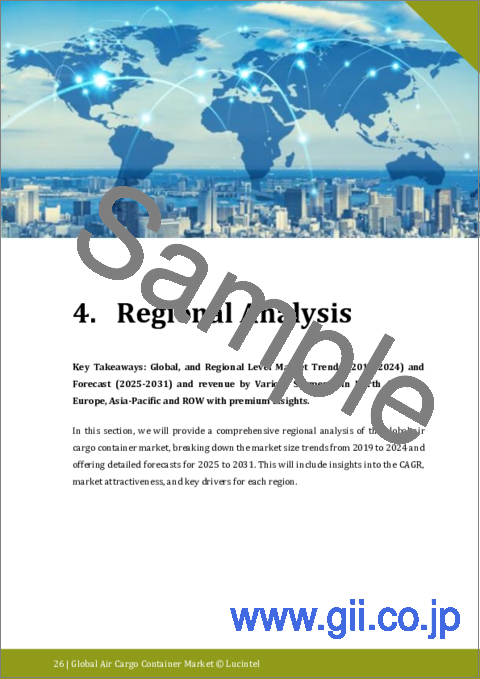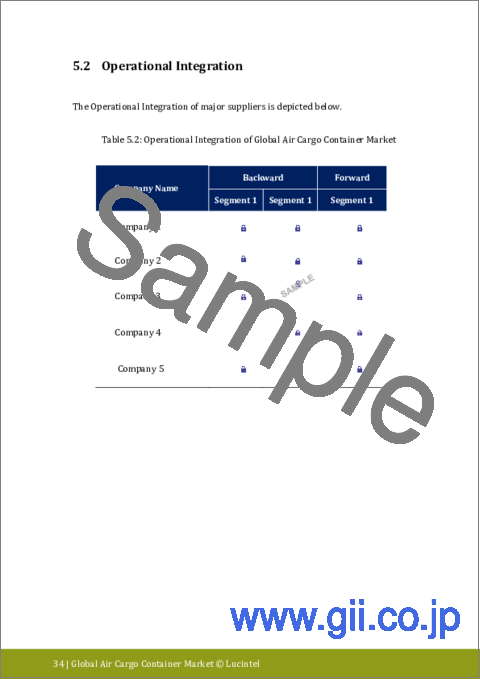|
|
市場調査レポート
商品コード
1664970
航空貨物コンテナ市場レポート:動向、予測、競合分析 (2031年まで)Air Cargo Container Market Report: Trends, Forecast and Competitive Analysis to 2031 |
||||||
カスタマイズ可能
適宜更新あり
|
|||||||
| 航空貨物コンテナ市場レポート:動向、予測、競合分析 (2031年まで) |
|
出版日: 2025年02月27日
発行: Lucintel
ページ情報: 英文 150 Pages
納期: 3営業日
|
全表示
- 概要
- 目次
世界の航空貨物コンテナ市場の将来は、新規販売と整備・修理市場に機会があり、有望視されています。世界の航空貨物コンテナ市場は、2025年から2031年までのCAGRが3.8%で、2031年までに推定5億米ドルに達すると予想されます。この市場の主な促進要因は、医薬品・生物製剤の輸出拡大とeコマース分野での需要の増加です。
- Lucintelの予測では、コンテナの種類別では、特殊貨物に対する需要の高まりにより、冷蔵セグメントが予測期間中に最も高い成長を遂げる見込みです。
- 最終用途産業カテゴリーでは、中国の民間航空機保有台数が急増し、8,600機以上の新造機需要があるため、新規販売が引き続き最大セグメントとなります。
- 地域別では、eコマース産業の拡大により、欧州が予測期間中に最も高い成長を遂げると予想されます。
航空貨物コンテナ市場の戦略的成長機会
航空貨物コンテナ市場は、技術主導のイノベーション、持続可能性への取り組み、世界のロジスティクスの力学の変化によって牽引されています。これらの機会を捉えることは、市場の成長とサービス提供の革新につながります。
- スマートコンテナソリューション:リアルタイムの追跡と監視を可能にするスマートコンテナの開発と利用は、ロジスティクスと貨物管理の効率を改善することで成長機会をもたらします。
- 持続可能なコンテナ材料:リサイクル可能なプラスチック容器の開発は、特に持続的な研究開発努力によって潜在的な成長をもたらします。環境に優しい容器は、環境意識の高い顧客を惹きつけます。
- 温度管理コンテナ:医薬品、生鮮品、その他のデリケートな商品のために特定の温度を維持する保温容器の需要が伸びており、さらなる機会を提供します。
- 自動化とロボット工学の統合:陸上コンテナ・オペレーションにおけるロボット工学と自動化によって、効率性、スピード、正確性、信頼性を向上させながら、マンパワーの必要性を削減することで、成長も可能です。
- カスタマイズとモジュール型ソリューション:カスタマイズ可能でモジュール化されたコンテナ設計は、多様な貨物ニーズを持つ顧客にアピールし、オペレーションの柔軟性とロジスティクス性能を向上させます。
航空貨物コンテナ市場は、スマートなソリューション、持続可能な素材、温度制御の革新、カスタマイズを通じて成長機会を提供し、効率性を促進し、進化する顧客ニーズに対応します。
航空貨物コンテナ市場の促進要因・課題
航空貨物コンテナ市場は、技術、経済要因、規制力学によって牽引され、市場促進要因・課題の両方が市場成長を形成しています。
航空貨物コンテナ市場を牽引する要因は以下の通り:
技術の進歩:よりスマートな技術と自動化の台頭により、効率性、追跡、監視機能が向上し、貨物の保護と業務効率が改善されます。
- 効率的なロジスティクスへの需要:効率的なロジスティクスへの需要:ロジスティクス・ソリューションに対する企業や消費者のニーズの高まりが、効率的な世界貿易とサプライ・チェーンに不可欠な先進的航空貨物コンテナへの需要を促進しています。
- 持続可能性の重視:環境に優しくリサイクル可能な素材を使用することで、世界の持続可能性目標をサポートし、環境意識の高い顧客を惹きつけ、市場の成長を後押しします。
- 温度変化に敏感な貨物:医薬品や生鮮品など、温度変化に敏感な貨物の輸送需要の増加が、航空貨物コンテナの断熱と温度制御の技術革新を促進します。
- eコマースの成長:eコマースの台頭により、オンライン注文のタイムリーな配達を確保するための効率的な航空貨物ソリューションへの需要が高まり、市場の成長が促進されます。
航空貨物コンテナ市場の課題は以下のとおりである:
- 初期コストの高さ:新世代の航空貨物コンテナは初期費用が高額であるため、ヘルスケアなど一部の業界では投資意欲が減退する可能性があります。
- 規制への対応:国によって安全規制や環境規制が異なるため、製品開発や市場開拓が制限される可能性があります。
- 技術統合の複雑さ:コンテナ・システムに高度な技術を導入するには、多額の資金と技術的リソースを必要とし、高価で複雑なものとなる可能性があります。
- 市場競争:メーカー間の激しい競争が収益性と市場シェアを圧迫し、各社は価格競争以上の差別化を迫られます。
- サプライチェーンの混乱:資材不足などサプライチェーンの混乱は、コンテナの生産と供給を制限し、市場の安定性に影響を与える可能性があります。
航空貨物コンテナ市場は、技術開発、持続可能性への取り組み、eコマースの成長、効率化要求などの影響を受けていますが、高コスト、規制上のハードル、競争などの課題に直面しています。これらの問題に対処することは、成長機会を生かし、市場力学に適応するための鍵となります。
目次
第1章 エグゼクティブサマリー
第2章 世界の航空貨物コンテナ市場:市場力学
- イントロダクション、背景、分類
- サプライチェーン
- 業界の促進要因と課題
第3章 市場動向と予測分析 (2019年~2031年)
- マクロ経済動向 (2019~2024年) と予測 (2025~2031年)
- 世界の航空貨物コンテナ市場の動向 (2019~2024年) と予測 (2025~2031年)
- 世界の航空貨物コンテナ市場:コンテナの種類別
- 冷蔵
- 非冷蔵
- 世界の航空貨物コンテナ市場:材料別
- 金属
- 複合材料
- 世界の航空貨物コンテナ市場:航空機別
- 旅客機
- 貨物機
- 軍用機
- 世界の航空貨物コンテナ市場:最終用途産業別
- 新規販売
- 整備・修理
第4章 地域別の市場動向と予測分析 (2019年~2031年)
- 世界の航空貨物コンテナ市場:地域別
- 北米の航空貨物コンテナ市場
- 欧州の航空貨物コンテナ市場
- アジア太平洋の航空貨物コンテナ市場
- その他地域の航空貨物コンテナ市場
第5章 競合分析
- 製品ポートフォリオ分析
- 運用統合
- ポーターのファイブフォース分析
第6章 成長機会と戦略分析
- 成長機会分析
- 世界の航空貨物コンテナ市場の成長機会:コンテナの種類別
- 世界の航空貨物コンテナ市場の成長機会:材料別
- 世界の航空貨物コンテナ市場の成長機会:航空機別
- 世界の航空貨物コンテナ市場の成長機会:最終用途産業別
- 世界の航空貨物コンテナ市場の成長機会:地域別
- 世界の航空貨物コンテナ市場の新たな動向
- 戦略的分析
- 新製品の開発
- 世界の航空貨物コンテナ市場の生産能力拡大
- 世界の航空貨物コンテナ市場における企業合併・買収 (M&A)、合弁事業
- 認証とライセンシング
第7章 主要企業のプロファイル
- Nordisk Aviation
- Granger Plastics
- Envirotainer
- Safran Aerosystems
- VRR Aviation
- ACL Airshop
- Unilode
The future of the global air cargo container market looks promising with opportunities in the new sales and maintenance & repair markets. The global air cargo container market is expected to reach an estimated $0.5 billion by 2031 with a CAGR of 3.8% from 2025 to 2031. The major drivers for this market are expanding the export of pharmaceuticals and biologics and increasing demand in the e-commerce sector.
- Lucintel forecasts that, within the container type category, the refrigerated segment is expected to witness the highest growth over the forecast period due to rising demand for specialized cargo.
- Within the end use industry category, new sales will remain the largest segment due to a surge in China's commercial aircraft fleet and demand for over 8,600 new aircraft.
- In terms of region, Europe is expected to witness the highest growth over the forecast period due to the expansion of the e-commerce industry.
Gain valuable insights for your business decisions with our comprehensive 150+ page report.
Emerging Trends in the Air Cargo Container Market
The water and air cargo container market is witnessing new trends that are attributable to technology, environmental concerns, and the quest for greater efficiency. Such developments are changing the packing, storage, and movement of cargo globally.
- Smart Container Technologies: Air cargo operations have evolved with the adoption of worldwide cargo tracking and management systems driven by IoT and sensor technologies for automated monitoring. Smart containers provide data on location, temperature, and humidity, enhancing logistics and securing valuable cargo.
- Sustainable Materials: The growth of air cargo containers is focusing on lighter, recyclable materials. This trend aligns with global sustainability efforts, reducing the environmental impact of container manufacturing and waste disposal.
- Advanced Insulation and Temperature Control: New structures enable better temperature regulation and insulation, crucial for shipping cold-chain products like medicines, fresh food, and precious goods that require specific conditions to maintain quality.
- Automation and Robotics: Automation in water freight containers is revolutionizing operations, with faster, more accurate performance and minimal manual sorting, loading, and unloading.
- Customization and Modular Designs: The demand for air cargo containers has driven the manufacture of custom and modular containers suited to different cargo types and volumes, enhancing logistics operations.
These trends are reshaping the air cargo container industry by leveraging smart technologies, eco-friendly materials, and innovations in insulation, automation, and customization. The industry is moving towards next-generation, efficient, and cost-effective logistics solutions.
Recent Developments in the Air Cargo Container Market
Recent developments in the air cargo container market include advancements in technology, materials, and design aimed at enhancing efficiency, safety, and sustainability.
- Smart Container Integration: IoT-enabled smart containers now offer real-time tracking and monitoring, improving operational efficiency and cargo security through enhanced visibility and control.
- Eco-friendly and Lightweight Containers: Lightweight, recyclable materials are increasingly being used, reducing fuel consumption and pollution while aligning with business goals and legal requirements.
- Improved Temperature Control: Advances in insulation and temperature control technologies have improved the handling of temperature-sensitive cargo, vital for transporting medicines, food, and other perishable goods.
- Automation in Handling Systems: Automated systems for loading and unloading air cargo containers are becoming more common, enhancing speed, accuracy, and efficiency while reducing human error.
- Modular and Bespoke Containerization: Structural shifts towards modular and bespoke containers are growing, offering various sizes and shapes to suit different cargo types, making operations more efficient and productive.
Recent developments in the air cargo container market focus on integrating smart technologies, adopting eco-friendly materials, improving temperature control mechanisms, increasing automation, and enhancing design flexibility. These advances aim to boost efficiency, security, and sustainability in air cargo logistics.
Strategic Growth Opportunities for Air Cargo Container Market
The air cargo container market is driven by technology-led innovations, sustainability initiatives, and shifting global logistics dynamics. Capturing these opportunities can lead to market growth and service delivery innovations.
- Smart Container Solutions: The creation and use of smart containers that offer real-time tracking and monitoring present growth opportunities by improving logistics and cargo management efficiency.
- Sustainable Container Materials: Developing recyclable plastic containers offers potential growth, especially with sustained R&D efforts. These eco-friendly containers attract environmentally conscious customers.
- Temperature-Controlled Containers: The demand for thermal containers that maintain specific temperatures for pharmaceuticals, perishables, and other sensitive goods is growing, offering further opportunities.
- Automation and Robotics Integration: Growth is also possible with robotics and automation in land-based container operations, increasing efficiency, speed, precision, and reliability in cargo management while reducing manpower needs.
- Customization and Modular Solutions: Customizable and modular container designs appeal to customers with diverse cargo needs, improving operational flexibility and logistics performance.
The air cargo container market offers growth opportunities through smart solutions, sustainable materials, temperature control innovations, and customization, fostering efficiency and meet evolving customer needs.
Air Cargo Container Market Driver and Challenges
The air cargo container market is driven by technology, economic factors, and regulatory dynamics, with both drivers and challenges shaping market growth.
The factors responsible for driving the air cargo container market include:
Technological Advancements: The rise of smarter technologies and automation increases efficiency, tracking, and monitoring capabilities, improving cargo protection and operational effectiveness.
- Demand for Efficient Logistics: Growing business and consumer needs for logistics solutions drive demand for advanced air cargo containers, which are vital for efficient world trade and supply chains.
- Sustainability Focus: The use of eco-friendly and recyclable materials supports global sustainability goals and attracts environmentally conscious customers, boosting market growth.
- Temperature-Sensitive Cargo: Increasing demand for transporting temperature-sensitive cargo, such as pharmaceuticals and perishables, drives innovations in insulation and temperature control for air cargo containers.
- E-commerce Growth: The rise of e-commerce increases the demand for efficient air cargo solutions to ensure timely delivery of online orders, driving market growth.
Challenges in the air cargo container market are:
- High Initial Costs: The high cost of new-generation air cargo containers may deter some industries, such as healthcare, from investing due to the significant upfront expenses.
- Regulatory Compliance: Varying safety and environmental regulations across countries can restrict product development and market expansion.
- Technological Integration Complexity: Implementing sophisticated technologies in container systems can be expensive and complex, requiring substantial financial and technical resources.
- Market Competition: Intense competition among manufacturers pressures profitability and market share, pushing companies to differentiate beyond price competition.
- Supply Chain Disruptions: Disruptions in supply chains, such as material shortages, can limit container production and availability, impacting market stability.
The air cargo container market is influenced by technological developments, sustainability efforts, e-commerce growth, and efficiency demands, but it faces challenges such as high costs, regulatory hurdles, and competition. Addressing these issues is key to capitalizing on growth opportunities and adapting to market dynamics.
List of Air Cargo Container Companies
Companies in the market compete on the basis of product quality offered. Major players in this market focus on expanding their manufacturing facilities, R&D investments, infrastructural development, and leverage integration opportunities across the value chain. through these strategies air cargo container companies cater increasing demand, ensure competitive effectiveness, develop innovative products & technologies, reduce production costs, and expand their customer base. Some of the air cargo container companies profiled in this report include-
- Nordisk Aviation
- Granger Plastics
- Envirotainer
- Safran Aerosystems
- VRR Aviation
- ACL Airshop
- Unilode
Air Cargo Container by Segment
The study includes a forecast for the global air cargo container market by container type, material, aircraft, end use industry, and region.
Air Cargo Container Market by Container Type [Analysis by Value from 2019 to 2031]:
- Refrigerated
- Non-Refrigerated
Air Cargo Container Market by Material [Analysis by Value from 2019 to 2031]:
- Metal
- Composite
Air Cargo Container Market by Aircraft [Analysis by Value from 2019 to 2031]:
- Passenger
- Freighter
- Military
Air Cargo Container Market by End Use Industry [Analysis by Value from 2019 to 2031]:
- New Sales
- Maintenance & Repair
Air Cargo Container Market by Region [Analysis by Value from 2019 to 2031]:
- North America
- Europe
- Asia Pacific
- The Rest of the World
Country Wise Outlook for the Air Cargo Container Market
Major players are expanding their operations and forming strategic partnerships to strengthen their market positions. Below are recent developments by key air cargo container producers in the USA, China, India, Japan, and Germany:
- United States: In the U.S., air cargo centers increasingly adopt IoT-integrated smart containers and sensors for real-time tracking. These innovations also improve safety standards and comply with stringent industry requirements, enhancing logistics efficiency.
- China: The production of lightweight, recyclable air cargo containers is growing rapidly in China, with new materials aimed at improving aerodynamic performance for better fuel efficiency and reduced carbon emissions. There is also a focus on expanding the container's biomechanical design capabilities.
- Germany: The German market emphasizes modernized air cargo containers with advanced insulation and temperature control, especially for sensitive cargo. The trend towards sustainable materials and processes is driven by strict environmental regulations.
- India: India is focusing on reducing air freight container costs and increasing supply, with a trend towards developing durable yet cost-effective containers that can withstand the country's varied weather conditions, supporting the logistics and e-commerce sectors.
- Japan: Japan is advancing the integration of robotics and mechanization in air cargo container operations. Developments include automated systems for loading and unloading, as well as smart containers with enhanced workspace technologies, contributing to a fast-moving logistics sector.
Features of the Global Air Cargo Container Market
Market Size Estimates: Air cargo container market size estimation in terms of value ($B).
Trend and Forecast Analysis: Market trends (2019 to 2024) and forecast (2025 to 2031) by various segments and regions.
Segmentation Analysis: Air cargo container market size by various segments, such as by container type, material, aircraft, end use industry, and region in terms of value ($B).
Regional Analysis: Air cargo container market breakdown by North America, Europe, Asia Pacific, and Rest of the World.
Growth Opportunities: Analysis of growth opportunities in different container type, material, aircraft, end use industry, and regions for the air cargo container market.
Strategic Analysis: This includes M&A, new product development, and competitive landscape of the air cargo container market.
Analysis of competitive intensity of the industry based on Porter's Five Forces model.
If you are looking to expand your business in this market or adjacent markets, then contact us. We have done hundreds of strategic consulting projects in market entry, opportunity screening, due diligence, supply chain analysis, M & A, and more.
This report answers following 11 key questions:
- Q.1. What are some of the most promising, high-growth opportunities for the air cargo container market by container type (refrigerated and non-refrigerated), material (metal and composite), aircraft (passenger, freighter, and military), end use industry (new sales and maintenance & repair), and region (North America, Europe, Asia Pacific, and the Rest of the World)?
- Q.2. Which segments will grow at a faster pace and why?
- Q.3. Which region will grow at a faster pace and why?
- Q.4. What are the key factors affecting market dynamics? What are the key challenges and business risks in this market?
- Q.5. What are the business risks and competitive threats in this market?
- Q.6. What are the emerging trends in this market and the reasons behind them?
- Q.7. What are some of the changing demands of customers in the market?
- Q.8. What are the new developments in the market? Which companies are leading these developments?
- Q.9. Who are the major players in this market? What strategic initiatives are key players pursuing for business growth?
- Q.10. What are some of the competing products in this market and how big of a threat do they pose for loss of market share by material or product substitution?
- Q.11. What M&A activity has occurred in the last 5 years and what has its impact been on the industry?
Table of Contents
1. Executive Summary
2. Global Air Cargo Container Market: Market Dynamics
- 2.1: Introduction, Background, and Classifications
- 2.2: Supply Chain
- 2.3: Industry Drivers and Challenges
3. Market Trends and Forecast Analysis from 2019 to 2031
- 3.1. Macroeconomic Trends (2019-2024) and Forecast (2025-2031)
- 3.2. Global Air Cargo Container Market Trends (2019-2024) and Forecast (2025-2031)
- 3.3: Global Air Cargo Container Market by Container Type
- 3.3.1: Refrigerated
- 3.3.2: Non-Refrigerated
- 3.4: Global Air Cargo Container Market by Material
- 3.4.1: Metal
- 3.4.2: Composite
- 3.5: Global Air Cargo Container Market by Aircraft
- 3.5.1: Passenger
- 3.5.2: Freighter
- 3.5.3: Military
- 3.6: Global Air Cargo Container Market by End Use Industry
- 3.6.1: New Sales
- 3.6.2: Maintenance & Repair
4. Market Trends and Forecast Analysis by Region from 2019 to 2031
- 4.1: Global Air Cargo Container Market by Region
- 4.2: North American Air Cargo Container Market
- 4.2.1: North American Air Cargo Container Market by Container Type: Refrigerated and Non-Refrigerated
- 4.2.2: North American Air Cargo Container Market by End Use Industry: New Sales and Maintenance & Repair
- 4.3: European Air Cargo Container Market
- 4.3.1: European Air Cargo Container Market by Container Type: Refrigerated and Non-Refrigerated
- 4.3.2: European Air Cargo Container Market by End Use Industry: New Sales and Maintenance & Repair
- 4.4: APAC Air Cargo Container Market
- 4.4.1: APAC Air Cargo Container Market by Container Type: Refrigerated and Non-Refrigerated
- 4.4.2: APAC Air Cargo Container Market by End Use Industry: New Sales and Maintenance & Repair
- 4.5: ROW Air Cargo Container Market
- 4.5.1: ROW Air Cargo Container Market by Container Type: Refrigerated and Non-Refrigerated
- 4.5.2: ROW Air Cargo Container Market by End Use Industry: New Sales and Maintenance & Repair
5. Competitor Analysis
- 5.1: Product Portfolio Analysis
- 5.2: Operational Integration
- 5.3: Porter's Five Forces Analysis
6. Growth Opportunities and Strategic Analysis
- 6.1: Growth Opportunity Analysis
- 6.1.1: Growth Opportunities for the Global Air Cargo Container Market by Container Type
- 6.1.2: Growth Opportunities for the Global Air Cargo Container Market by Material
- 6.1.3: Growth Opportunities for the Global Air Cargo Container Market by Aircraft
- 6.1.4: Growth Opportunities for the Global Air Cargo Container Market by End Use Industry
- 6.1.5: Growth Opportunities for the Global Air Cargo Container Market by Region
- 6.2: Emerging Trends in the Global Air Cargo Container Market
- 6.3: Strategic Analysis
- 6.3.1: New Product Development
- 6.3.2: Capacity Expansion of the Global Air Cargo Container Market
- 6.3.3: Mergers, Acquisitions, and Joint Ventures in the Global Air Cargo Container Market
- 6.3.4: Certification and Licensing
7. Company Profiles of Leading Players
- 7.1: Nordisk Aviation
- 7.2: Granger Plastics
- 7.3: Envirotainer
- 7.4: Safran Aerosystems
- 7.5: VRR Aviation
- 7.6: ACL Airshop
- 7.7: Unilode





